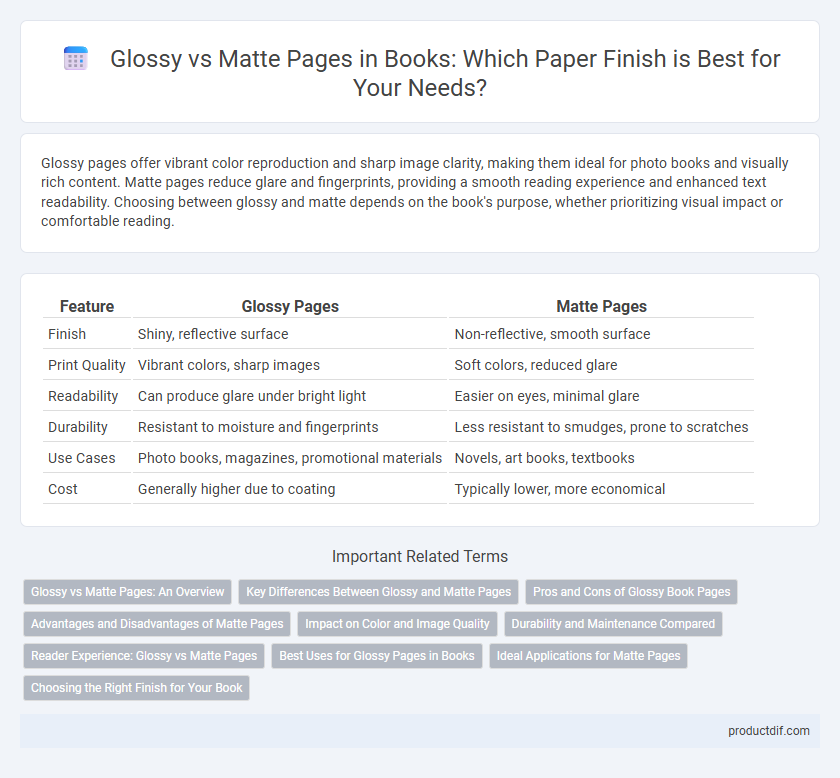Glossy pages offer vibrant color reproduction and sharp image clarity, making them ideal for photo books and visually rich content. Matte pages reduce glare and fingerprints, providing a smooth reading experience and enhanced text readability. Choosing between glossy and matte depends on the book's purpose, whether prioritizing visual impact or comfortable reading.
Table of Comparison
| Feature | Glossy Pages | Matte Pages |
|---|---|---|
| Finish | Shiny, reflective surface | Non-reflective, smooth surface |
| Print Quality | Vibrant colors, sharp images | Soft colors, reduced glare |
| Readability | Can produce glare under bright light | Easier on eyes, minimal glare |
| Durability | Resistant to moisture and fingerprints | Less resistant to smudges, prone to scratches |
| Use Cases | Photo books, magazines, promotional materials | Novels, art books, textbooks |
| Cost | Generally higher due to coating | Typically lower, more economical |
Glossy vs Matte Pages: An Overview
Glossy pages in books offer a smooth, shiny finish that enhances color vibrancy and image sharpness, making them ideal for photo-heavy content and marketing materials. Matte pages provide a non-reflective, muted surface that reduces glare and increases readability, often preferred for text-intensive books and professional reports. The choice between glossy and matte pages impacts the visual appeal, tactile experience, and overall durability of printed materials.
Key Differences Between Glossy and Matte Pages
Glossy pages feature a shiny, reflective finish that enhances color vibrancy and sharpness, making them ideal for photo books and magazines. Matte pages offer a non-reflective surface that reduces glare, providing easier readability and a smoother texture preferred for novels and professional reports. The choice between glossy and matte pages significantly impacts the visual appeal, readability, and tactile experience of printed books.
Pros and Cons of Glossy Book Pages
Glossy book pages offer vibrant color reproduction and sharp image clarity, making them ideal for photo-heavy books and visual impact. However, their reflective surface can cause glare under bright lighting and is more prone to fingerprints and smudges, which may affect readability and durability. The smooth texture enhances contrast but may feel less natural to some readers compared to the softer, non-reflective finish of matte pages.
Advantages and Disadvantages of Matte Pages
Matte pages in books offer reduced glare and better readability under bright lighting, making them ideal for extended reading sessions. They tend to resist fingerprints and smudges more effectively than glossy pages, maintaining a cleaner appearance over time. However, matte finishes can slightly dull colors and images, resulting in less vibrant illustrations compared to glossy pages.
Impact on Color and Image Quality
Glossy pages enhance color vibrancy and sharpness by reflecting light, making images appear richer and more detailed, ideal for photo-heavy books. Matte pages reduce glare and fingerprints, offering a softer, more muted color palette that supports readability and a sophisticated aesthetic. Choosing between glossy and matte pages directly affects the visual impact and overall perception of image quality in printed books.
Durability and Maintenance Compared
Glossy pages offer a smooth, shiny finish that resists fingerprints and moisture, enhancing durability and ease of cleaning. Matte pages provide a non-reflective surface that reduces glare and minimizes visible scratches but may absorb oils and stains more readily. Maintenance for glossy pages is simpler with a damp cloth, while matte pages require gentle handling to avoid abrasion and retain their quality over time.
Reader Experience: Glossy vs Matte Pages
Glossy pages enhance reader experience by offering vibrant colors and sharp images, ideal for photo books and visual-heavy content, but they can cause glare under bright lighting, which may strain the eyes during extended reading. Matte pages provide a smooth, non-reflective surface that reduces glare and fingerprints, creating a comfortable reading experience for text-heavy books and prolonged use. Choosing between glossy and matte pages depends on the balance between visual appeal and reading comfort tailored to the book's purpose.
Best Uses for Glossy Pages in Books
Glossy pages in books enhance the vibrancy of images and colors, making them ideal for photo books, art catalogs, and magazines where visual impact is crucial. Their smooth, reflective surface allows for sharp, high-contrast prints that highlight intricate details and textures. Glossy pages also provide better durability against fingerprints and smudges, ensuring a polished and professional appearance throughout the book.
Ideal Applications for Matte Pages
Matte pages are ideal for books that require minimal glare and enhanced readability, such as novels, textbooks, and journals. Their non-reflective surface reduces eye strain during extended reading sessions and suits books with dense text or intricate illustrations. Matte finishes also work well for products needing a sophisticated, understated aesthetic without distracting shine.
Choosing the Right Finish for Your Book
Glossy pages offer vibrant colors and sharp images, making them ideal for photo books and visually rich publications. Matte pages reduce glare and fingerprints, providing a smoother reading experience better suited for text-heavy books or artistic prints. Selecting the right finish depends on your book's purpose, audience, and the desired aesthetic impact to enhance readability and visual appeal.
Glossy Pages vs Matte Pages Infographic

 productdif.com
productdif.com